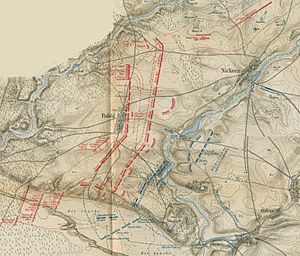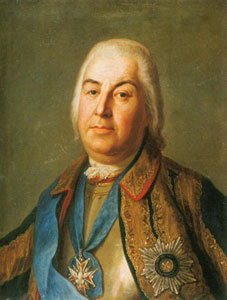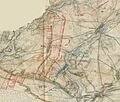Battle of Kay facts for kids
Quick facts for kids Battle of Kay |
|||||||
|---|---|---|---|---|---|---|---|
| Part of the Third Silesian War | |||||||
 Map of the battle of Kay |
|||||||
|
|||||||
| Belligerents | |||||||
| Commanders and leaders | |||||||
| Strength | |||||||
| 40,000–41,000 | 26,000–27,500 | ||||||
| Casualties and losses | |||||||
| 4,804–5,000 | 6,800–8,300 | ||||||
The Battle of Kay (also called the Battle of Sulechów or Paltzig) was a big fight during the Seven Years' War. It happened on July 23, 1759, near a town called Kay in what is now Poland.
In this battle, the Prussian army, led by General Carl Heinrich von Wedel, attacked a much larger Russian army. The Russians, commanded by Count Pyotr Saltykov, had about 41,000 soldiers. The Prussians had around 26,000. The battle ended with a clear Russian victory. The Prussians lost many soldiers, between 6,800 and 8,300, while the Russians lost about 4,800.
After this defeat, the Prussian King Frederick II of Prussia wanted to fight the Russians again. He hoped to stop them from joining forces with the main Austrian army. Just three weeks later, the Prussians faced the combined Russian and Austrian armies at the Battle of Kunersdorf.
Contents
The Seven Years' War in 1759
By 1759, Prussia was mostly defending itself in the war. When spring arrived, King Frederick gathered his army in Silesia. This move kept the main Austrian army busy in Bohemia. However, the Russian army moved west into Poland. They marched towards the Oder river, which was a big threat to Prussia's main lands, Brandenburg, and even Berlin.
Frederick sent two groups of soldiers to stop the Russians. General Friedrich August von Finck led one group, and Christoph II von Dohna led another to help Finck.
The Austrians and Russians had a plan. The Austrians moved to the border between Lusatia and Silesia. From there, their commander, Leopold Joseph von Daun, could move into either area. On July 8, the Allies held a meeting. Saltykov wanted to cross into Silesia. Daun was still unsure, but he did send some extra troops with Ernst Gideon von Laudon. Daun was worried about what King Frederick and his brother, Prince Henry, might do.
Frederick moved his army on July 4, heading northwest. At the same time, his brother Henry marched his army from Saxony into Silesia. These movements separated Daun's army from Saltykov's. Daun knew Loudon's troops weren't enough to fully support the Russians. So, he also sent András Hadik's 17,000 soldiers to help. Hadik's troops had been watching Henry's army. On July 22, Hadik left Henry's force and crossed into Lusatia.
Armies Get Ready for Battle
Empress Elizabeth of Russia ordered Saltykov to move into Prussia in June 1759. His army was about 41,000 men strong. When King Frederick learned of this, he told General Dohna to stop the Russians. Dohna had about 26,000 soldiers, including many cavalry.
In mid-July, Dohna and Saltykov played a game of cat and mouse. Saltykov kept moving closer to the Prussian border. On July 14, he turned southwest, heading for the Oder river. By July 19, he reached the Silesian front near Züllichau. Saltykov planned to let his troops rest there for a few days.
Saltykov was new to leading the Russian army. He spent time learning about his soldiers' strengths and weaknesses. He also met with his officers, but he kept the Austrian commanders out of these meetings. This showed he didn't fully trust the Austrian staff.
King Frederick was watching all this from afar. He was not happy with Dohna's slow actions. So, he sent Carl Heinrich von Wedel to take command. Wedel arrived on July 20. He set up a blocking position at Züllichau to stop the Russians from entering Prussian land and reaching the Oder river. Wedel wanted to attack the next morning, but he couldn't find a weak spot in the Russian defenses.
On July 20, Saltykov took control of the Prussian supply line at the Oder. This made his position even stronger. It also cut off any Prussian help from Crossen or Frankfurt on the Oder. The Russians held high ground near Kay and Mosau. A swampy stream, the Eichmühlen Fliess, was to the east of Kay. It could only be crossed at one narrow point on the road east of Kay. Another crossing was south of Kay, which would let them attack the Russian right side. Wedel thought this was a good idea, but only if the Russians weren't fully ready.
By July 23, Wedel had direct orders from King Frederick. The King wanted him to find a "good position" (meaning strong ground) and use the "oblique order" attack style. Wedel knew he had to fight the Russians before they moved on Frankfurt. He also knew his reputation with the King was at stake. On July 23, Wedel sent scouts to check Saltykov's troops near Kay. He saw them moving and thought they were heading for Frankfurt. So, he ordered his army to advance on the Russian right side. Wedel believed his best chance was to take the Paltzig heights before the Russians did. The best way to do that was through Kay.
The Battle Begins
The Prussian army marched in two groups towards Kay. One group took the road directly to Kay, and the other went towards Mosau. As soon as they came out of the valleys around the town, they ran into some Russian scouts. The Prussians pushed back these first groups, but then more Russian soldiers arrived, and the full battle began. The Russians fired at the Prussians from the high ground around Kay.
General Heinrich von Manteuffel led six battalions to attack the Russian artillery. At first, the Russians pushed them back. There were three attacks at Kay that afternoon, and each one failed. General Manteuffel was injured during one of these attacks.
Wedel then ordered a full cavalry charge through the woods against the Russian right side. But the Russian forces were stronger and pushed back the Prussians. The Prussians didn't have enough backup troops, so their attack slowed down. Repeated attacks on the Russians, who were dug in on the heights, caused huge losses for the Prussians. In the last of these attacks, Moritz Franz Kasimir von Wobersnow led eight battalions and six cavalry groups. His cavalry broke through the enemy's foot soldiers, but the Russian cavalry, with help from their cannons, pushed them back into the lower ground.
After the Battle
In the second attack, General Manteuffel was hurt. In the final attack, General Wobersnow was killed. Wedel lost up to 8,300 of his soldiers.
The loss at Kay opened the way to the Oder river for the Russians. By July 28, Saltykov's troops reached Crossen. However, he didn't enter Prussia right away. This was mainly because he had problems with the Austrians. Saltykov and Daun didn't trust each other. Saltykov didn't speak German and didn't trust the translator. Daun didn't want to risk losing his whole army. Even though Frederick and his brother had moved their armies, Daun worried they might turn back. This could stop him from joining Saltykov and expose his army to Frederick's powerful force.
Instead, Daun sent his extra troops, led by Loudon, to join Saltykov. When Saltykov heard this, he thought Daun was too slow and hesitant. Eventually, Hadik and Loudon joined forces on July 29. Daun also sent more help to Loudon, some of the best Austrian regiments. Daun believed that by the time Loudon reached the Oder, his force would be at least 20,000 strong. This would be enough to support Saltykov's already large army.
On August 3, the Russians took over Frankfurt. The main Russian army camped outside the city and started building defenses. They were getting ready for King Frederick's arrival. By the next week, Daun's reinforcements joined Saltykov's forces at Kunersdorf.
Images for kids




